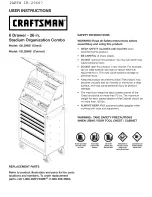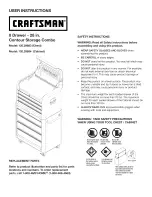
Appendix B. Telecommunications Commands
B-4
1243K
Reset Error Counter
This command resets the communications error counter (the number beginning
with ‘E’) to zero, then displays the status line. Neither the programs nor the
data stored in the module are affected by this command.
1248K
Reset Storage Module
Erases all data and programs, resets all pointers, fully tests memory and places
a File Mark at the beginning of memory. If a bad flash memory block is
encountered, the Storage Module will use only the good memory up to the bad
block. The number of good flash memory blocks is indicated in the Status.
During Reset, a plus (+) for each block written to, and a minus (-) for each
block successfully read is output by the Storage Module. An ‘X’ is output for
each RAM which cannot be read successfully. The status is displayed
following command execution. If the Storage Module returns a ‘%’ without a
‘<cr><lf>,’ the memory test failed.
ALL DATA IS LOST WHEN THE STORAGE MODULE IS
RESET. Be sure to collect data before resetting the
Storage Module.
1249K
Quick Reset
This command is similar to the 1248K command — it also erases all data and
programs. However, it does not do a complete memory test, it simply resets the
memory pointers and instructs the flash memory to erase itself. This is much
faster than the 1248K command and is designed for routine erasure of the
module. If the module has been corrupted, use the 1248K command instead.
A module with damaged memory requires a full memory test to determine how
much usable memory remains. The switches are not changed to their default
settings.
abfeL
Switch Settings
‘a’ is the Storage Module Address Switch. When used with a CR500/510,
CR10/10X or CR23X, this switch can be set to 1...8. The address has no effect
when used with other Campbell Scientific dataloggers. Following reset, the
Storage Module address defaults to 1.
‘b’ is the Baud Rate Switch – this is not currently used in the flash modules.
This switch always defaults to a value of 4, for compatibility with older
modules.
‘f’ is the Fill and Stop/Ring Memory Status Switch. If set to ‘0,’ the memory
is ring type. If ‘1,’ the memory is set to Fill and Stop and once memory is full,
further efforts to write to the Storage Module are aborted. The memory status
switch defaults to ‘0’ (ring memory) following Storage Module Reset.
‘e’ is the Encode ASCII Switch. This switch is not currently supported in the
flash module, it defaults to a value of zero indicating data is stored without any
encoding.
Entering 9 for switch settings leaves the switch setting unchanged. Example:
9990L would only disable the Encode ASCII function. Since position is
important, the 9’s are used to fill the first 3 spaces without changing the
settings.
M or *
Disconnect
The Storage Module is deactivated to a low power standby mode. If the
communications interface is (via) the CR500/510, CR10/10X, CR23X the
datalogger “ *” prompt will be returned.
N
OS Signature
Returns the Storage Module operating system signature. If this command
returns ‘0,’ the operating system is bad.
CAUTION
Summary of Contents for SM16M
Page 6: ...SM4M 16M Flash Storage Module Table of Contents iv This is a blank page...
Page 14: ...Section 1 SM4M SM16M Storage Module Overview 1 8 This is a blank page...
Page 22: ...Section 3 The Printer Enable Method of Data Storage 3 4 This is a blank page...
Page 40: ...This is a blank page...
Page 42: ...This is a blank page...
Page 44: ...This is a blank page...
Page 45: ...This is a blank page...








































